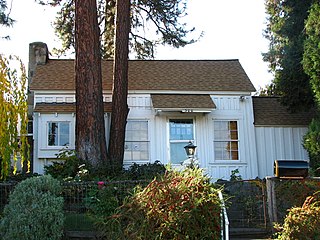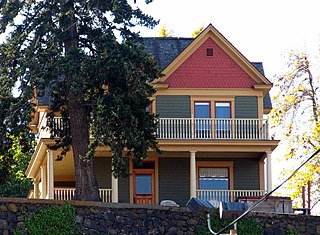
The Dalles Carnegie Library is a historic former library building located in The Dalles, Oregon, United States. It is one of the thousands of libraries whose construction was funded by Andrew Carnegie. The construction grant of $10,000 was approved in March 1907, and it was dedicated in September 1910.

The Dalles Civic Auditorium is a historic building on the National Register of Historic Places located at the corner of Fourth and Federal streets in The Dalles, Oregon. It is currently owned by the Civic Auditorium Historic Preservation Committee, a non-profit corporation formed specifically for the purpose of purchasing it from the City of The Dalles to save it from scheduled demolition, restore it, and operate it as a local and regional cultural center.

Old Saint Peter's Landmark, commonly referred to simply as Old St. Peter's, is a historic building located at the corner of 3rd and Lincoln Streets in downtown The Dalles, Oregon, United States. It was built in 1897 and dedicated on March 17, 1898 as St. Peter's Church, and served the local Roman Catholic congregation as its place of worship until 1968. It was saved from scheduled demolition in 1971 by a group of concerned citizens who formed Old St. Peter's Landmark, Inc., for that specific purpose, and which maintains the building as a museum and site for weddings, concerts and other cultural events.

The Edward F. Sharp Residential Ensemble, also known as the Sharp Family Residential Ensemble, is a set of three adjacent historic houses in The Dalles, Oregon, United States. Edward Sharp (1865–1954) was the county surveyor and roadmaster whose work underlies much of the development in The Dalles and Wasco County. As the official surveyor for the Eastern Oregon Land Company, he also conducted important early surveys across large stretches of Oregon and Idaho. He built the houses at 400 and 404 E. 4th Street for himself and his family, and the house at 504 Federal Street for employees (1900). Because the houses remained under common ownership in the Sharp family for many years, they have retained an exceptional level of preservation. The houses on 4th Street are also exceptional local examples of the Queen Anne (400) and Craftsman (404) styles.

The Bennett–Williams House is a historic house, located in The Dalles, Oregon, United States. It is listed on the National Register of Historic Places, and is also listed as a contributing resource in the National Register-listed Trevitt's Addition Historic District.

The Original Wasco County Courthouse is a historic former courthouse, located in The Dalles, Oregon, United States. It is listed on the National Register of Historic Places under the name First Wasco County Courthouse, and is also listed as a contributing resource in the National Register-listed Trevitt's Addition Historic District.

The Heimrich–Seufert House is a historic house in The Dalles, Oregon, United States.

The Rorick House Museum, also known as the Malcolm A. Moody House, is a museum located in The Dalles, Oregon, United States. The building was originally built in 1850 as a two-room residence for non-commissioned officers from Fort Dalles, this is the oldest remaining house in The Dalles. It was subsequently occupied by U.S. Representative Malcolm A. Moody, and has ultimately become a museum. The house is the current headquarters for the Wasco County Historical Society.

The Lewis Anderson House, Barn and Granary is a historic ensemble of buildings, currently located in The Dalles, Oregon, United States. This well-preserved set of 1890s Swedish American vernacular architecture was originally located on a farm on Pleasant Ridge, south of The Dalles. Lewis Anderson was a Swedish immigrant who, after establishing himself on Pleasant Ridge, worked semi-successfully to encourage further Swedish settlement in the area of The Dalles. The sidehill barn, with grade entrances on two levels, was the first erected of the ensemble, in 1890. The house was built by Anderson and fellow Swedish immigrant Ab Pearson in 1895. Anderson purchased and relocated the granary from a neighboring farm in 1898, in the process repurposing it from its previous function as a house.

The Hugh Glenn House is a historic house located in The Dalles, Oregon, United States. It is one of the most notable and historically well-preserved Queen Anne-style houses in The Dalles. Hugh Glenn, a prominent architect and businessman in The Dalles, designed and built the house around 1882 and lived there until his death in 1927.

The Edward French House is a historic house located in The Dalles, Oregon, United States. Originally dating from circa 1865, it was acquired by the French family in 1892 and renovated by them in the Italianate style in circa 1900. Edward French, along with his uncle Daniel and other members of the French family, were prominent bankers and businessmen from early The Dalles until the 1920s.

The John and Murta Van Dellen House is a historic house located in The Dalles, Oregon, United States. Built in 1920, it is the outstanding example of a California bungalow in The Dalles. Original owner John Van Dellen was a prosperous lumber yard owner, and made use of the finest local building materials and craftsmanship in constructing his house.

The Orlando Humason House is a historic house located in The Dalles, Oregon, United States. Humason (1828–1875), the "Father of Wasco County", lived in this modest Gothic Revival house from its construction in 1860 until his death. Originally from Ohio, he worked in law, prospecting, agriculture, and journalism, prior to settling in The Dalles as a prosperous merchant and river transport businessman. Representing first Oregon City then The Dalles in the territorial and state legislatures, he introduced legislation establishing Wasco County, Multnomah County, and the City of The Dalles. He also championed a bill to build a canal around the Cascades Rapids to allow Lower Columbia shipping to reach The Dalles, which did not come to fruition in his lifetime. Humason's other public positions included mayor of The Dalles and Wasco County judge. The house is architecturally notable as one of very few Gothic Revival houses in The Dalles.

The former United States Post Office in The Dalles, Oregon, United States, is a historic building constructed in 1916. Executed from standardized federal plans in the Greek Revival style, it was the first federal building in The Dalles and one of a set of nine built in Oregon in the 1910s. It remained in operation as a post office longer than seven of the other eight in that group. The building was added to the National Register of Historic Places in 1985.

The Dalles Commercial Historic District comprises a primarily commercial and civic portion of downtown The Dalles, Oregon, United States. Strategically located at the eastern end of the Columbia River Gorge and near Celilo Falls, The Dalles became the preeminent transportation and trading hub of the interior Northwest in the 19th and early 20th centuries. The 46 historic buildings and other features of the district, built between 1860 and 1938, reflect the city's status and evolution as the gateway to the Columbia Plateau and the commercial, governmental, and cultural center of Eastern Oregon.

The Dalles Mint was to be a branch of the United States Mint in The Dalles in Oregon. Partially constructed in 1869, the planned two-story structure was never completed and the mint was never put into operation. Located in the downtown area of the city, the building was given to the state before it was sold to the public. The Mint building was most recently home to the Erin Glenn Winery.

The Joseph D. and Margaret Kelly House is a historic residence in The Dalles, Oregon, United States. Joseph Kelly, a highly successful farmer during the establishment of wheat as a major cash crop in Wasco County, retired young to this 1908 blufftop house and continued his career as a landlord and businessman. He and his wife Margaret, a teacher and member of another important wheat family, became a prominent philanthropic figures in The Dalles. The house is architecturally notable for its vernacular rendering of the Queen Anne style, reflecting the Kellys' rural background in contrast to the high Victorian approach used elsewhere in The Dalles.

The Dr. J. A. Reuter House is a historic house in The Dalles, Oregon, United States. John Alexander Reuter (1876–1954) practiced medicine in The Dalles for 44 years (1902–1946), joining a partnership that established the city's first hospital (1901) and nursing school, as well as a large private clinic (1937). He bought this house in 1909 and radically transformed it by jacking the old house up to become the second floor and building a new first floor beneath. He also completely remodeled it to become the city's finest example of the Craftsman style.



















